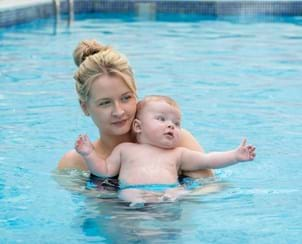 Taking babies swimming should be an enjoyable experience but with so much information on the internet about hyponatremia and secondary drowning, it is a wonder anyone goes swimming at all! As with all scaremongering, there has to be a scientific argument to back it up and quite often there isn’t! Hopefully this article will settle any fears parents may have about taking their babies swimming.
Taking babies swimming should be an enjoyable experience but with so much information on the internet about hyponatremia and secondary drowning, it is a wonder anyone goes swimming at all! As with all scaremongering, there has to be a scientific argument to back it up and quite often there isn’t! Hopefully this article will settle any fears parents may have about taking their babies swimming.
HYPONATREMIA
What is Hyponatremia?
Hyponatremia is a condition that occurs when the level of sodium in your blood is abnormally low. Sodium is an electrolyte and it helps regulate the amount of water that is in and around your cells. It is also referred to as water intoxication.
What causes Hyponatremia?
In hyponatremia, one or more factors – ranging from an underlying medical condition to drinking too much water during endurance sports – causes the sodium in your body to become diluted. When this happens, your body’s water levels rise, and your cells begin to swell. This swelling can cause many health problems, from mild to life-threatening.
Can Hyponatremia occur in Baby Swimming Lessons?
No! A study by Karl G Rosen* has shown that a baby needs to drink at least 10% of its body weight for the risk of water intoxication to occur. In a study of 15 babies below the age of 6 months, undertaking a 20 minute swimming session consisting of between 5 and 10 submersions, 7 of the babies increased their body weight by a maximum of 1.6%. This means that a baby would need to be submerged between 30 and 50 times in a swimming lesson for hyponatremia to occur! As the Swimming Teacher’s Association (STA) stipulate no more than six submersions in babies under the age of six months – all qualified and professional swimming teachers would never go anywhere near this amount.
SECONDARY DROWNING
What is Secondary Drowning?
Secondary drowning occurs when water enters the lungs and causes irritation. This can result in a build-up of fluid in the alveoli which can impair oxygen transfer which can cause a severe form of pneumonia which in itself is often fatal. Secondary drowning can occur for up to 72 hours after the drowning incident so it is important that teachers/swimmers/guardians of swimmers are aware of this as medical attention would be needed immediately.
What causes Secondary Drowning?
Quite often the term ‘near drowning’ is given to those who have been struggling in water, unable to bring their head above the surface of the water to take a breath and so they have inhaled water which then goes into their lungs. This should not be confused with swallowing water which is completely different. For a person to be at risk of suffering from secondary drowning they must have inhaled the water into their lungs. This occurs when a child/adult is put into a situation where they are underwater for a considerable amount of time and the oxygen in their blood has depleted which results in the need to inhale under water.
What are the symptoms?
Symptoms can occur up to 72 hours after the ‘near drowning’ event. They include:
- Trouble breathing
- Chest pain
- Cough
- Sudden changes in behaviour
- Extreme fatigue
Most important of all is that the child/adult has been in a situation where they have inhaled water. If this has not happened then the above symptoms will probably be from a common illness such as a cold, flu or viral infection.
What are the risks in supervised swimming sessions?
It is important to understand that there are no reported cases of secondary drowning from supervised swimming sessions in the UK. Secondary drowning can only occur if a child/adult is put into a situation where they are underwater for a considerable amount of time and the oxygen in their blood has depleted which results in the need to inhale under water. This should not ever be an issue in swimming lessons even if the children are in the water without their parents as teachers are highly trained to recognise any distress a child is in when swimming independently.
It is also important to note that secondary drowning is more likely to happen in salt water or spa pools where chemical levels are higher than in swimming pools. This is because the chemicals can affect the oxygen in the blood quicker than fresh water or chlorine/bromine treated pools
*Karl G Rosen, MD, Phd, published by the Swedish Paediatric Association in collaboration with the Swedish Board of Health and Welfare together with the Swedish Swimming Association.


